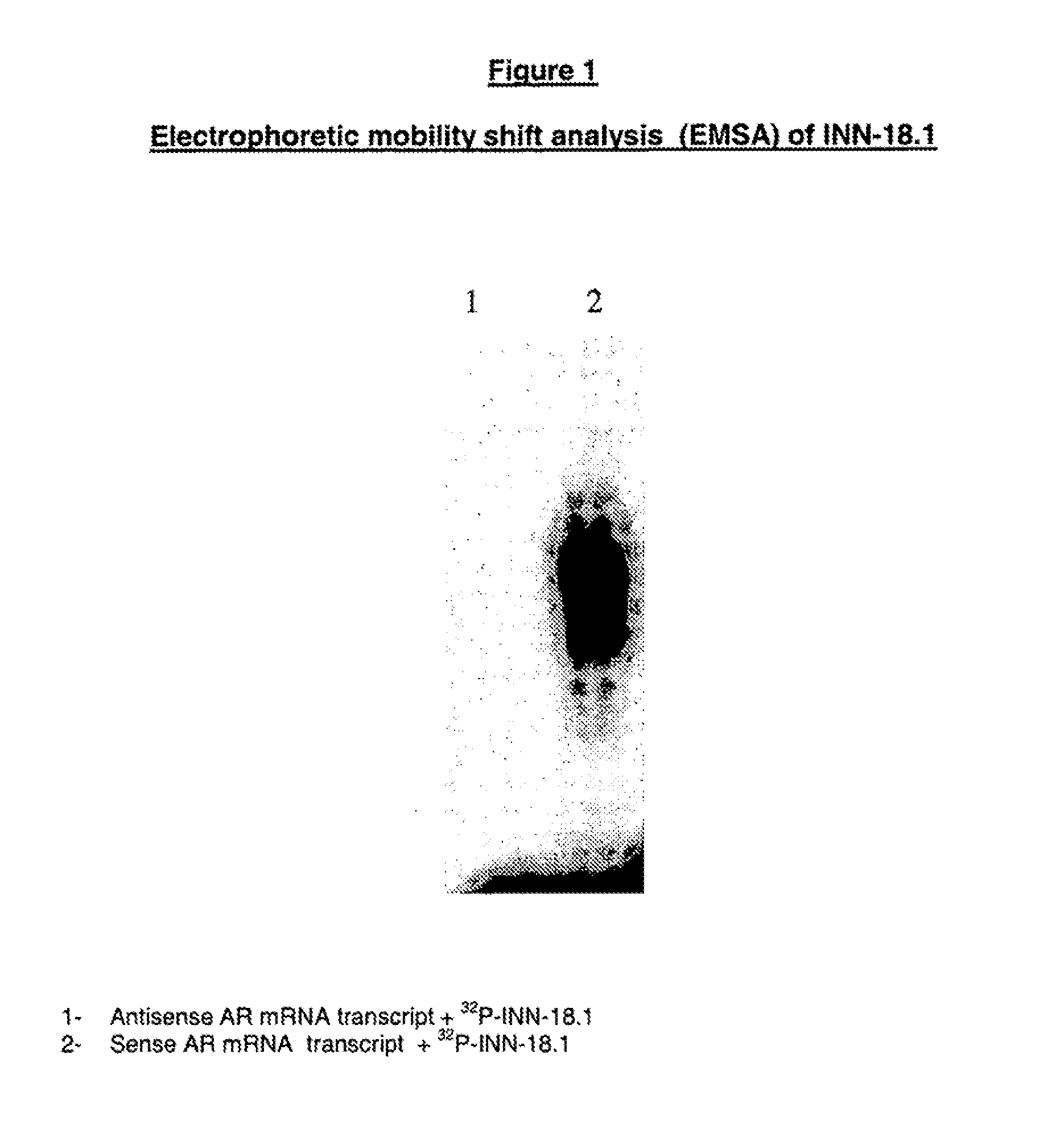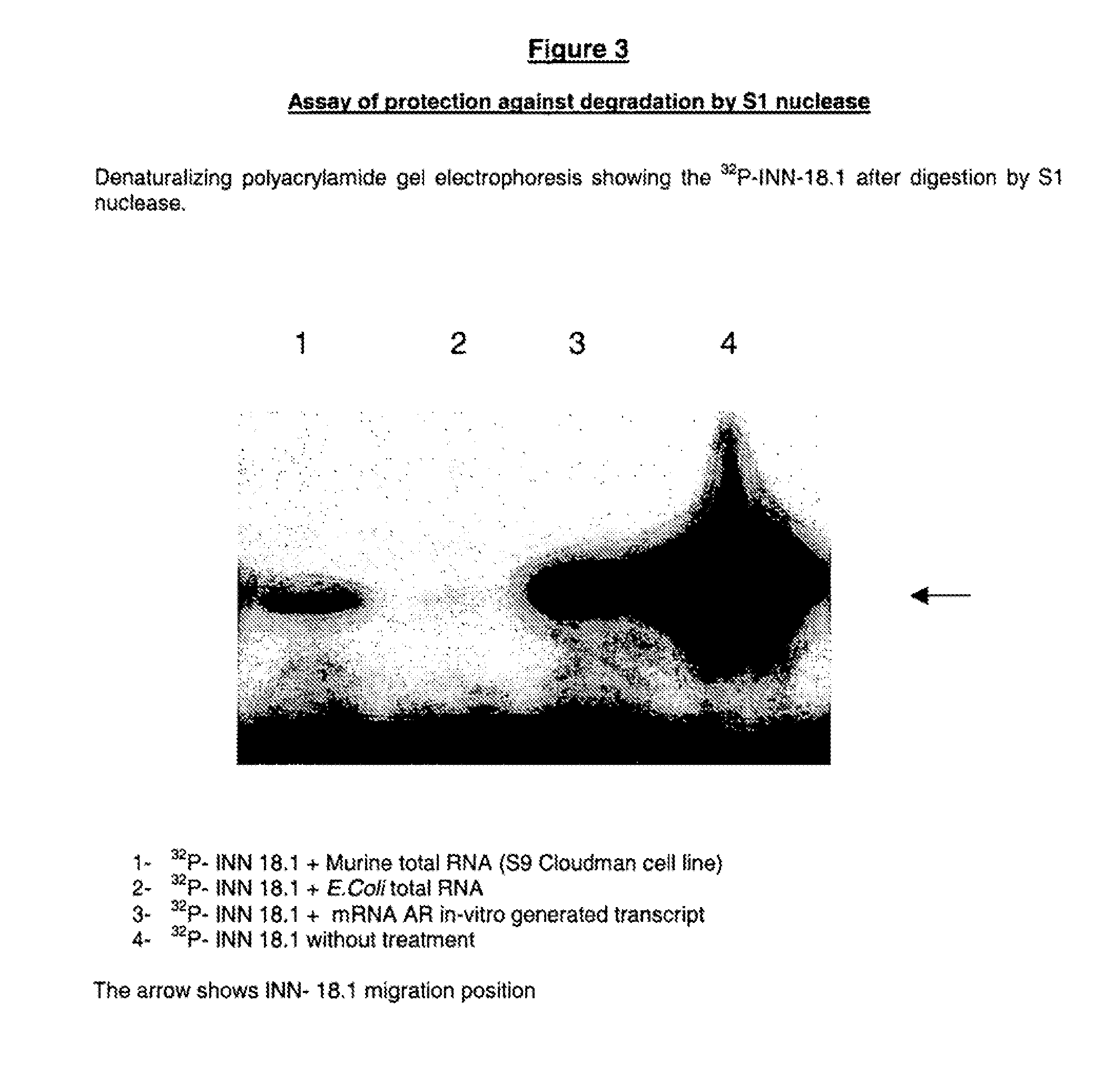Antiandrogen oligonucleotides usable for the treatment of dermatological androgen-related disorders relating to androgen metabolism, their pharmaceutical compositions, their uses and treatment method
a technology of androgen metabolism and anti-androgen oligonucleotides, applied in the field of new drugs, can solve the problems of reducing affecting the treatment effect, and affecting the quality of life of patients, and achieve the effect of inhibiting androgen-related hair loss and skin conditions
- Summary
- Abstract
- Description
- Claims
- Application Information
AI Technical Summary
Benefits of technology
Problems solved by technology
Method used
Image
Examples
example 1
In Vitro Assesment of the Designated Active Principles—Electrophoretic Mobility Shift Analysis (EMSA)
[0125]The electrophoretic mobility shift analysis comprises the following steps:
[0126]a) Radio-Labeling of Oligonucleotides
[0127]The oligonucleotides were labeled by incubation at 37° C. for 30 minutes at a final volume of 25 microL:
[0128]50 mM Tris-Cl pH 7.5
[0129]10 mM MgCl2
[0130]5 mM DTT
[0131]10 pmol dephosphorylated oligonucleotides, at the 5′ end
[0132]20 pmol (150 microCi) [gamma-32P]ATP (specific activity >3000 Ci / mmol)
[0133]50 microg / ml BSA
[0134]3 U T4 polynucleotide kinase
[0135]The reaction was stopped by heating at 60° C. for 5 minutes and an extraction was carried out with phenol / chloroform. Labelled oligonucleotides were separated from free ATP labelled by 20% polyacrylamide gel electrophoresis. Labelled oligonucleotides were identified by auto-radiography, sliced from gel and eluted at 37° C. during a whole night to a final volume of 120 microL of DEPC-treated water
[0136]...
example 2
S1 Nuclease Digestion Protection Assay
[0152]This technique indicates that both the ODN hybridize with the AR mRNA, preventing the oligonucleotide degradation, and the hybridization is complete or partial.
[0153]Partial hybridization (only a few nucleotides manage to hybridize with the target sequence) leads to a partial protection of the oligonucleotide molecule which, in turn, migrates faster in the gel electrophoresis. Complete hybridization (the whole oligonucleotide sequence hybridizes with the mRNA), results in a full-length oligonucleotide after the S1 digestion;
[0154]The S1 nuclease digestion protection assay consists of the following steps:
[0155]a) Oligonucleotide Radio-Labeling and Purification.
[0156]As described in item a) of the EMSA assay.
[0157]b) In Vitro Transcription of Unlabeled Androgen Receptor (AR) mRNA
[0158]As described in item b) of the EMSA assay.
[0159]c) Hybridization of In Vitro Transcribed Androgen Receptor (AR) mRNA with Radio-Labeled Oligonucleotides
[0160]A...
example 3
[0166]This technique can show that the hybridization capability of the ODN's could trigger an RNAse H mechanism of mRNA digestion which, within the cells, will be responsible for the androgen receptor messenger (AR-mRNA) degradation. This mechanism leads to the diminution of the AR expression, thus an anti-androgenic activity can be displayed. The RNAse H degradation involves the following steps:
[0167]a. Oligonucleotide Radio-Labeling and Purification.
[0168]As described in item a) of the EMSA assay
[0169]b. In Vitro Transcription of the Androgen Receptor (AR) mRNA as Described in Item b) of the EMSA Assay
[0170]c. Nuclease S1 Digestion
[0171]The labeled AR mRNA transcript was incubated for 1 hour at 37° C. with 1.25 microM of the oligodeoxynucleotide and 0.25 U / microL of RNAse H in a buffer containing 100 mM NaCl; 10 mM phosphate pH=7, 0.1 mM EDTA and 1 mM MgCl2. Digestions were carried out in a total volume of 10 microL.
[0172]d. Casting of Denaturing Gel, ...
PUM
| Property | Measurement | Unit |
|---|---|---|
| temperature | aaaaa | aaaaa |
| pH | aaaaa | aaaaa |
| molecular composition | aaaaa | aaaaa |
Abstract
Description
Claims
Application Information
 Login to View More
Login to View More - R&D
- Intellectual Property
- Life Sciences
- Materials
- Tech Scout
- Unparalleled Data Quality
- Higher Quality Content
- 60% Fewer Hallucinations
Browse by: Latest US Patents, China's latest patents, Technical Efficacy Thesaurus, Application Domain, Technology Topic, Popular Technical Reports.
© 2025 PatSnap. All rights reserved.Legal|Privacy policy|Modern Slavery Act Transparency Statement|Sitemap|About US| Contact US: help@patsnap.com



